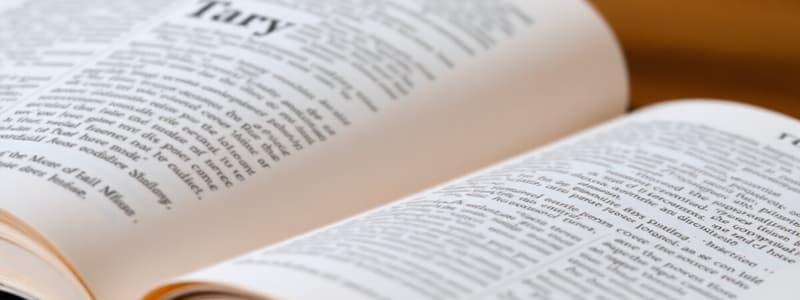Podcast
Questions and Answers
A protagonist who undergoes significant internal changes throughout a story, influenced by the events they experience, is best described as which type of character?
A protagonist who undergoes significant internal changes throughout a story, influenced by the events they experience, is best described as which type of character?
- Flat
- Foil
- Static
- Dynamic (correct)
In a narrative, an antagonist is a character that:
In a narrative, an antagonist is a character that:
- Undergoes significant personal growth.
- Opposes the main character, creating conflict. (correct)
- Serves as the narrator of the story.
- Mirrors the protagonist's traits and values.
If a character's struggle originates from a clash between their own desires and societal norms, this is an example of which conflict type?
If a character's struggle originates from a clash between their own desires and societal norms, this is an example of which conflict type?
- Person against nature.
- Person against fate.
- Person against society. (correct)
- Person against person.
What is the effect of using first-person point of view in storytelling?
What is the effect of using first-person point of view in storytelling?
Which literary device involves a comparison of two unlike things using 'like' or 'as'?
Which literary device involves a comparison of two unlike things using 'like' or 'as'?
Which point of view allows the narrator to access the thoughts and feelings of multiple characters and move freely through different settings?
Which point of view allows the narrator to access the thoughts and feelings of multiple characters and move freely through different settings?
How does foreshadowing typically function in a narrative?
How does foreshadowing typically function in a narrative?
What is the primary purpose of imagery in writing?
What is the primary purpose of imagery in writing?
A character who serves to highlight, through contrast, the qualities of another character is known as:
A character who serves to highlight, through contrast, the qualities of another character is known as:
Which literary device involves attributing human qualities to inanimate objects or abstract concepts?
Which literary device involves attributing human qualities to inanimate objects or abstract concepts?
Flashcards
Point of view
Point of view
Perspective from which the story is written; can be omniscient, first-person, or shift between characters.
First-person
First-person
The story is told by one of the characters.
Third-person limited
Third-person limited
The author relates the story through one character's perspective, limiting the field of vision to that character.
Third-person omniscient
Third-person omniscient
Signup and view all the flashcards
Symbol
Symbol
Signup and view all the flashcards
Tone
Tone
Signup and view all the flashcards
Character
Character
Signup and view all the flashcards
Antagonist
Antagonist
Signup and view all the flashcards
Protagonist
Protagonist
Signup and view all the flashcards
Static character
Static character
Signup and view all the flashcards
Dynamic character
Dynamic character
Signup and view all the flashcards
Round character
Round character
Signup and view all the flashcards
Conflict
Conflict
Signup and view all the flashcards
External conflict
External conflict
Signup and view all the flashcards
Internal conflict
Internal conflict
Signup and view all the flashcards
Connotation
Connotation
Signup and view all the flashcards
Figures of speech
Figures of speech
Signup and view all the flashcards
Personification
Personification
Signup and view all the flashcards
Metaphor
Metaphor
Signup and view all the flashcards
Simile
Simile
Signup and view all the flashcards
Flashback
Flashback
Signup and view all the flashcards
Foil
Foil
Signup and view all the flashcards
Foreshadow
Foreshadow
Signup and view all the flashcards
Imagery
Imagery
Signup and view all the flashcards
Study Notes
- These are terms to know for the ELA Author and Perspective Test on March 13th
Point of View
- Point of view is the perspective from which the story is written.
- Point of view can be omniscient (all-knowing), first-person ("I"), or shifting between characters.
First-Person
- The story is told in the first person by one of the characters and has become increasingly popular.
Third-Person Limited
- The author chooses a character, and the story is related in terms of that character, confining the field of vision to him or her alone.
Third-Person Omniscient
- The author moves from character to character, place to place, and episode to episode with complete freedom, accessing characters' thoughts and feelings whenever providing information as wished.
- This is the most common point of view.
Symbol
- A symbol is a word or object with meaning in itself but stands for something else.
- Symbols are a concrete way of representing something abstract, such as a dove symbolizing peace, or the seven rooms in "The Masque of the Red Death" representing the seven stages of man.
Tone
- Refers to the speaker's attitude towards what he/she is saying.
Character
- A character is a person or animal who appears in a work of fiction.
Antagonist
- A person who opposes or competes with the main character, hero, or heroine; often the villain.
Protagonist
- The main character, hero, or heroine, in a written work.
Character Types
Static
- A character who changes little if at all in the progress of the narrative.
- Things happen to such a character without things happening within him.
- The pattern of action reveals the character rather than showing the character changing in response to the actions, sometimes gives the appearance of changing simply because our picture of him is revealed bit by bit.
- Short stories are more likely to reveal static characters through action than to show changes in characters resulting from actions.
Dynamic
- A character who is modified by the actions through which he passes.
- One of the objectives of the work in which he appears is to reveal the consequences of these actions upon him.
- Most great dramas and novels have dynamic characters as protagonists.
Flat
- A character who does not change in the course of a story or play and is one-dimensional.
Round
- A character who develops and thus alters; a fully fleshed out, multi-dimensional character.
Conflict
- The struggle or clash between opposing characters or opposing forces.
External
- A character struggles against an outside force like another character, society as a whole, or something in nature.
Internal Conflict
- Takes place entirely within a character's own mind.
- It is a struggle between opposing needs, desires, or emotions within a single person.
Types of Conflicts Occur in Fiction
- Person against person (problem with another character)
- Person against society (problem with the laws or beliefs of a group of people)
- Person against nature (problem with a force of nature or some aspect of the environment, such as a blizzard, high winds, a mountain to climb)
- Person against self (problem with deciding what to do, think, or feel)
- Person against fate (problem that seems beyond the character's control)
Connotation
- The feeling behind a word (positive, negative, neutral, warm, dark, etc.)
Figures of Speech (Figurative Language)
- Writing or speech not meant to be interpreted literally.
- Language is used to create vivid word pictures, to make writing emotionally intense and concentrated, and to state ideas in new and unusual ways.
- Examples include simile, personification, and paradox.
Personification
- A literary device where writers gives human qualities to objects or ideas.
- Ex: Fear raised its ugly head.
- Ex: During the earthquake, the desk walked across the room.
Metaphor
- Comparison of unlike things without using the words like or as.
- Ex: Her lips were rose petals.
Simile
- Comparison of one thing to another using the words like or as.
- Ex: Her lips were like rose petals.
Flashback
- Jumping backward in the chronology of a narrative, often through a dream or musing sequence.
Foil
- A character who has opposite personality traits to another character.
- Their opposite characteristics help draw out key differences between them.
Foreshadow
- Hints during the narrative about what will happen later; can be literal hints or symbolic hints.
Imagery
- Creation of mental pictures or sensation by pertinent word choice and heightened description which appeal to the five senses.
- Ex: His leathery, sun-abused face was ridged like corrugated cardboard.
Terms to know
- Important terms to know: Metaphor, Point-of-view (all of them), Central Conflict, Stanza, Symbolism, and Theme.
Studying That Suits You
Use AI to generate personalized quizzes and flashcards to suit your learning preferences.




